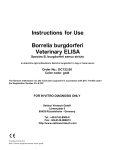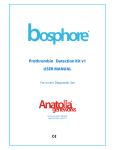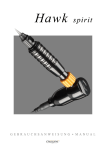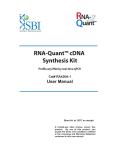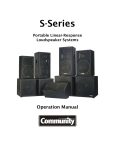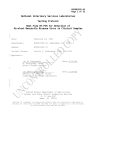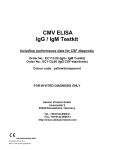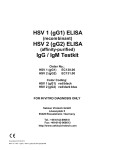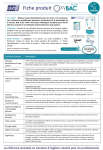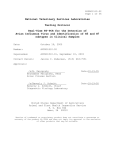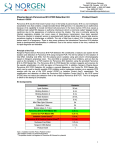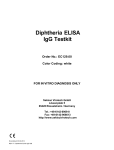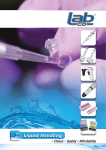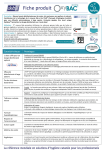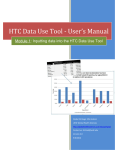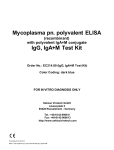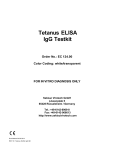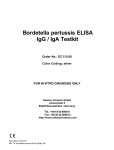Download Package Insert
Transcript
Measles ELISA IgG Testkit Order No.: EC105G00 Color Coding: grey FOR IN VITRO DIAGNOSIS ONLY Sekisui Virotech GmbH Löwenplatz 5 65428 Rüsselsheim / Germany Tel.: +49-6142-6909-0 Fax: +49-6142-966613 http://www.sekisuivirotech.com Druckdatum 03.02.2014 REV 12 / Masern ELISA IgG GB Contents 1. Intended Use ......................................................................................................................... 3 2. Diagnostic Relevance ............................................................................................................ 3 3. Test Principle......................................................................................................................... 4 4. Package Contents (IgG Te stkit) ............................................................................................. 4 5. Storage and Shelflife of the Testkit and the ready to use reagents ....................................... 4 6. Precautions and Warnings .................................................................................................... 4 7. Material required but not supplied......................................................................................... 5 8. Test Procedure ...................................................................................................................... 5 8.1 8.2 8.3 8.4 9. Examination Material....................................................................................................................................................... 5 Preparation of Reagents ................................................................................................................................................. 5 Virotech ELISA Test Procedure....................................................................................................................................... 5 Usage of ELISA processors ............................................................................................................................................ 6 Test Evaluation ...................................................................................................................... 6 9.1 9.2 9.3 9.4 Test function control........................................................................................................................................................ 6 Calculation of the Vir otech Units (VE) ............................................................................................................................. 6 Interpretation Scheme IgG .............................................................................................................................................. 6 Limits of the Test............................................................................................................................................................. 7 10. Performance Data .................................................................................................................. 7 10.1 10.2 10.3 10.4 10.5 Sensitivity and Specif icity ................................................................................................................................................ 7 Cross Reactiv ity .............................................................................................................................................................. 7 Prevalence (Expected Values) ........................................................................................................................................ 7 Intra-assay-Coefficient of Variation (Repeatability).......................................................................................................... 7 Inter-assay-Coefficient of Variation (Reproducibility)....................................................................................................... 8 11. Literature ............................................................................................................................... 8 12. Test Procedure Scheme ........................................................................................................ 9 Seite 2 v on 9 Masern ELISA IgG GB REV 12 Druckdatum 03.02.2014 1. Intended Use The Measles ELISA is intended for the detection of an acute or recent infection w ith Measles respectively for the detection of vaccination antibodies. 2. Diagnostic Relevance The disease is caused by an RNA virus w hich is an exclusively human pathogen. It is a member of the Morbillivirus genus, Paramyxovirus family. Measles is transmitted by direct contact, by inhalation of infectious droplets of expired air, or by infectious secretions fr om the nose or throat. The measles virus produces an infection even on brief exposure, w ith an index of contagion close to 100%, and provokes clinical symptoms in over 95% of unprotected infected individuals. The incubation period is 8-10 days to the start of the catarrhal stage and 14 days to the appearance of the rash (1). The prevalence of IgG antibodies in the German population varies w ith age, lying betw een 77% at 2-4 years and 99.5% at ≥40 years (2). The initial symptoms of measles are fever, conjunctivitis, coryza, coughing, and a rash on the palate. A pathognomonic feature is Koplik’s spots, w hich can often be demonstrated. The characteristic maculopapular rash of measles develops on the 3rd to 7th day after onset of the initial symptoms. On day 5 to 7 of the illness, the temperature falls. Infection w ith measles confers lifelong immunity. Subacute sclerosing panencephalitis (SSPE) is a very rare late complication, occurring in 1-5 cases per million patients; it develops after a mean of 6-8 years follow ing infection. It starts w ith psychological and intellectual changes, and runs a progressive course with neurological disturbances and failure of function, culminating in the loss of cerebral function. The prognosis is alw ays poor. We recommend VIROTECH Measles CSF Standards for the diagnosis of SSPE. In immunosuppressed individuals or those w ith cellular immune deficiency, measles infections may superficially appear mild - the measles rash may not develop, or may have an atypical appearance; how ever, severe organ complications may occur in the form of progressive giant-cell pneumonia or measles inclusion-body encephalitis, both of w hich have a mortality of around 30%. The measles vaccine is a live virus vaccine prepared from attenuated measles virus. The vaccine of choice is MMR (a combined vaccine containing measles, mumps and rubella inocula). The primary vaccination should be given at the age of 11-14 months, i.e. after the disappearance of maternal antibodies. The vaccines licensed in Germany produce seroconversion in about 90% of individuals after primary vaccination. Up to 5% of vaccinated children show w hat is know n as vaccine-strain measles, w ith moderate fever, a fleeting rash and respiratory symptoms, mostly occurring in the second w eek after vaccination. The immune response produced by vaccination is detectable after 4-6 w eeks. Measles show s a fairly typical clinical picture, so laboratory tests to conf irm the clinical diagnosis have in the past been the exception. With the introduction of protective vaccination, clinical measles has become very much rarer here, w ith the result that the diagnosis is uncertain in some cases, and laboratory diagnostic techniques have become increasingly important. A w ide range of methods are available for laboratory diagnosis, involving the detection of specific antibodies or of the viru s itself. The detection of virus-specific IgM antibodies, as a marker of an ongoing disease process, is currently the quickest and safest method; as a rule it becomes positive at the time of onset of the rash, but it may remain negative up to day 3 of the rash in up to 30% of patients. IgM antibodies may persist for up to 6 w eeks or even longer, making it possible to diagnose an exanthematous disease retrospectively. In vaccinated individuals experiencing a reinfection, in w hom no clear IgM response is seen, a negative finding does not rule out the diagnosis of measles. In such cases, a further serum sample should be investigated after an interval of 7-10 days. If the patient has measles, ELISA (IgG) or a complement fixation test can then demonstrate a significant rise in antibody titres in the paired sera. Viral cultures are extremely expensive and only justifiable in exceptional cases. A positive demonstration of measles virus RNA by RT-PCR in patient samples taken shortly before the onset of the rash confirms acute infection in the same w ay as the demonstration of IgM antibodies. How ever, a negative finding in the viral genome test does not rule out the disease (1). Where the clinical picture suggests measles, virological and serological studies for differential diagnosis should be aimed primarily at ruling out rubella, erythema infectiosum [f ifth disease], adenoviruses, enteroviruses and HHV -6 (3). Seite 3 v on 9 Masern ELISA IgG GB REV 12 Druckdatum 03.02.2014 3. Test Principle The antibody searched for in the human serum forms an immune complex w ith the antigen coated on the microtiter -plate. Unbound immunoglobulins are removed by w ashing processes. The enz yme conjugate attaches to this complex. Unbound conjugate is again removed by w ashing processes. After adding the substrate solution (TMB), a blue dye is produced by the bound enzyme (peroxidase). The color changes to yellow w hen the stopping solution is added. 4. Package Contents (IgG Testkit) 1. 2. 3. 4. 5. 6. 7. 8. 9. 5. 1 Microtiter-Plate consisting of 96 with antigen coated, breakable single w ells, lyophilised PBS-Dilution Buffer (blue, ready to use) 2x50m l, pH 7,2, w ith preservative and Tw een 20 PBS-Washing Solution (20x concentrated) 50m l, pH 7,2, w ith preservative and Tw een 20 IgG negative Control, 2000µl, human serum w ith protein-stabilizer and preservative, ready to use IgG cut-off Control, 2000µl, human serum w ith protein-stabilizer and preservative, ready to use IgG positive Control, 2000µl, human serum w ith protein-stabilizer and preservative, ready to use IgG-Conjugate (anti-human), 11ml, (sheep or goat)-horseradish-peroxidase-conjugate with protein-stabilizer and preservative in Tris-Buffer, ready to use Tetramethylbenzidine s ubstrate solution (3,3’,5,5’-TMB), 11m l, ready to use Citrate-Stopping Solution, 6m l, contains an acid mixture Storage and Shelflife of the Testkit and the ready to use reagents Store the testkit at 2-8°C. The shelf life of all components is show n on each respective label; for the kit shelf life please see Quality Control Certificate. 1. 2. 3. Microtiter strips/single w ells are to be resealed in package after taking out single w ells and stored w ith desiccant at 2-8°C. Reagents should immediately be returned to storage at 2-8°C after usage. The ready to use conjugate and the TMB-substrate solution are sensitive to light and have to be stored in dark. Should there be a color reaction of the substrate dilution due to incidence of light, it is not useable anymore. Take out only the amount of ready to use conjugate or TMB needed for the test insertion. Additional conjugate or TMB taken out may not be returned but must be dismissed. Material Status Diluted Undiluted After Opening Test Samples Controls Microtitreplate After Opening Rheumatoid factor Absorbent Conjugate Tetramethylbenzidine Stop Solution Undiluted, After Opening Diluted After Opening After Opening After Opening After Opening Final Dilution (ready-to-use) Washing Solution 6. Storage +2 to +8°C +2 to +8°C +2 to +8°C +2 to +8° (storage in the provided bag w ith desiccant bag) +2 to +8°C +2 to +8°C +2 to +8°C (protect from light) +2 to +8°C (protect from light) +2 to +8°C +2 to +8°C +2 to +25°C Shelflife max. 6h 1 w eek 3 months 3 months 3 months 1 w eek 3 months 3 months 3 months 3 months 4 w eeks Precautions and Warnings 1. 2. 3. Only sera w hich have been tested and found to be negative for HIV -1 antibodies, HIV-2 antibodies, HCV antibodies and Hepatitis-B surface-antigen are used as control sera. Nevertheless, samples, diluted samples, controls, conjugates and microtiter strips should be treated as potentially infectious material. Please handle products in accordance with laboratory directions. Those components that contain preservatives, the Citrate Stopping Solution and the TMB have an irritating effect to skin, eyes and mucous. If body parts are contacted, immediately w ash them under flow ing water and possibly consult a doctor. The disposal of the used materials has to be done according to the country-specific guidelines. Seite 4 v on 9 Masern ELISA IgG GB REV 12 Druckdatum 03.02.2014 7. Material required but not supplied 1. 2. 3. 4. 5. 6. 7. 8. 9. 10. 8. Aqua dest./demin. Eight-channel pipette 50µl, 100µl Micropipettes: 10µl, 100µl, 1000µl Test tubes Paper tow els or absorbent paper Cover for ELISA-plates Disposal box for infectious material ELISA handw asher or automated EIA plate w ashing device ELISA plate spectrophotometer, w avelength = 450nm, reference length = 620nm (Reference Wavelength 620-690nm) Incubator Test Procedure Working exactly referring to the Sekisui Virotech user manual is the prerequisite for obtaining correct results. 8.1 Examination Material Either serum or plasma can be used as test material, even if only serum is mentioned in the instructions. Any type of anticoagulant can be used for plasma. Alw ays prepare patient-dilution freshly. For a longer storage the sera must be frozen. Repeated defrosting should be avoided. 1. Only fresh non-inactivated sera should be used. 2. Hyperlipaemic, haemolytic, microbially contaminated and turbid sera should not to be used (false positive/negative results). 8.2 Preparation of Reagents The Sekisui Virotech System Diagnostica offers a high degree of flexibility regarding the possibility to use the dilution buffer, w ashing solution, TMB, citrate stopping solution as w ell as the conjugate for all parameters and for all different lots. The ready to use controls (positive control, negative control, cut-off control) are param eter specific and only to use w ith the plate lot indicated in the Quality Control Certificate. 1. Set incubator to 37°C and check proper temperature setting before start of incubation. 2. Bring all reagents to room temperature before opening package of microtiter strips. 3. Shake all liquid components w ell before use. 4. Make up the w ashing solution concentrate to 1 L w ith distilled or demineralised w ater. If crystals have formed in the concentrate, please bring the concentrate to room temperature before use and shake w ell before use. 8.3 Virotech ELISA Test Procedure 1. 2. 3. 4. 5. 6. 7. 8. 9. For each test run, pipette 100µl each of ready to use dilution buffer (blank), IgG-positive, negative and cut-off control as w ell as diluted patient sera. We propose a double insertion (blank, controls and patient sera); for cut-off control a double insertion is absolutely necessary. Working dilution of patient sera: 1+100; e.g. 10µl serum + 1ml dilution buffer. After pipetting start incubation for 30 min. at 37°C (w ith cover). End incubation period by w ashing microtiter strips 4 times w ith 350 – 400µl w ashing solution per w ell. Do not leave any w ashing solution in the w ells. Remove residues on a cellulose pad. Pipette 100µl of ready to use conjugate into each w ell. Incubation of conjugates: 30 min. at 37°C (w ith cover). Stop conjugate incubation by w ashing 4 times (pls. refer to point 3 above). Pipette 100µl of ready to use TMB into each w ell. Incubation of substrate solution: 30 min. at 37°C (w ith cover, keep in dark). Stopping of substrate reaction: pipette 50µl of citrate stopping solution into each w ell. Shake plate carefully and thoroughly until liquid is completely mixed and a homogeneous yellow color is visible. Seite 5 v on 9 Masern ELISA IgG GB REV 12 Druckdatum 03.02.2014 10. Measure extinction (OD) at 450/620nm (Reference Wavelength 620-690nm). Set your photometer in such a w ay that the blank value is deducted from all other extinctions. Extinctions should be measured w ithin 1 hour after adding the stopping solution! Pls. refer to last page for Test Procedure Scheme 8.4 Usage of ELISA processors All Sekisui Virotech ELISAs can be used on ELISA processors. The user is bound to proceed a validation of the devices (processors) on a regular basis. Sekisui Virotech recommends the follow ing procedure: 1. Sekisui Virotech recommends to proceed the validation of device referring to the instructions of the device manufacturer during the implementation of the ELISA processor respectively after bigger reparations. 2. It is recommended to check the ELISA-processor w ith the Validationkit (EC250.00) afterw ards. A regular check using the Validationkit shall be proceeded minimum once a quarter to test the accuracy of the processor. 3. The release criteria of the Quality Control Certificate of the product must be fulfilled for each testrun. With this procedure, your ELISA processor w ill function properly and this w ill support quality assurance in your laboratory. 9. Test Evaluation The ready to use controls serve for a semiquantitative determination of specific IgG antibodies. Their concentration can be expressed in Virotech units = VE. Fluctuations resulting from the test procedure can be balanced w ith this calculation method and a high reproducibility is achieved in this w ay. Use the means of the OD values for calculation of the VE. 9.1 Test function control a) OD-values The OD of the blank should be < 0.15. The OD-values of the negative controls should be low er than the OD-values mentioned in the Quality Control Certificate. The OD-values of the positive controls as w ell as of the cut-off controls should be above the OD-values mentioned in the Quality Control Certificate. b) Virotech Units (VE) The Virotech Units (VE) of the cut-off controls are defined as 10 VE. The calculated VE of the positive controls should be w ithin the ranges mentioned in the Quality Control Certificate. If those requirements (OD-values, VE) are not fulfilled, the test has to be repeated. 9.2 Calculation of the Virotech Units (VE) The extinction of the blank value (450/620nm) has to be subtracted from all other extinctions. OD (positive control) x 10 OD (cut-off control) OD (patient serum) x 10 OD (cut-off control) VE (positive control) VE (patient serum) 9.3 Interpretation Scheme IgG Result (VE) < 9,0 9,0 - 11,0 > 11,0 Seite 6 v on 9 Masern ELISA IgG GB Evaluation negative borderline positive REV 12 Druckdatum 03.02.2014 1. 2. 3. If the measured values are above the defined borderline range, they are considered to be positive (please take notice of vaccination management!). If the measured VE is w ithin the borderline range, no significant high antibody concentration is present, the samples are considered to be borderline. For the secure detection of an infection it is necessary to determine the antibody concentration of tw o serum samples. One sample shall be taken directly at the beginning of the infection and a second sample 5 – 10 days later (convalescent serum). The antibody concentration of both samples has to be tested in parallel, that means in one test run. A correct diagnosis based on the evaluation of a single serum sample is not possible. If the measured values are below the defined borderline range, no measurable antigen specific antibodies are present in the samples. The samples are considered to be negative. 9.4 Limits of the Test The interpretation of serological results shall alw ays include the clinical picture, epidemiological data and all further available laboratory results. 10. Performance Data 10.1 Sensitivity and Specificity For the detection of analytical sensitivity and specificity 199 sera w ere tested. These sera are from routine tests by the virology of the University of Cologne (n=163) and children’s sera from the children’s hospital Leipzig (n=36). The comparison w as made to a commercially available ELISA. Reference Elisa VT Measles IgG Elisa negative positive negative 45 0 positive 2 141 10 sera could not be clearly identified in the reference system. One borderline Serum w as not included into the calculation. The analytical sensitivity is 98,6% and the analytical specificity is > 99,8%. 10.2 Cross Reactivity The occurrence of cross-reactions against Measles IgG antibodies against human pathogens is not to be expected (4). 10.3 Prevalence (Expected Values) To determine the prevalence 119 blood bank sera w ere tested. The prevelance for Measles IgG is betw een 77% (2-4 years) and 99.5% (≥40 years) because of the high virulence and vaccination rate. num ber (%) negative 2 1,7 borderline 2 1,7 positive 115 96,6 10.4 Intra-assay-Coefficient of Variation (Repeatability) In one assay, strips of different plates of one batch have been tested w ith the same serum sample. The obtained coefficient of variation is < 9% (at an average OD-value of 0,19). Seite 7 v on 9 Masern ELISA IgG GB REV 12 Druckdatum 03.02.2014 10.5 Inter-assay-Coefficient of Variation (Reproducibility) Three sera w ere tested in 10 independent test runs by different persons in different laboratories. Measles ELISA IgG Serum negative Average Value VE 2,75 Coefficient of Variation 26,4% borderline 9,44 11,0% positive 56,10 7,4% 11. Literature 1. 2. 3. 4. RKI-Ratgeber Infektionskrankheiten – Merkblätter für Ärzte – Masern. im Februar 2002 aktualisierte Fassung, Erstveröffentlichung 5.11.1999. http://www.rki.de/INFEKT/INFEKT.HTM?/INFEKT/INF_A -Z/RATMBL/RATMBL2.HTM&1 Gerike, Tischer, Santibanez, Einschätzung der Masernsituation in Deutschland, Bundesgesundheitsbl – Gesundheitsforsch – Gesundheitsschutz 2000 – 43:11 – 21, Springer Verlag 2000, S. 17 Tabelle 2. http://www.rki.de/GESUND/IMPFEN/BGBL0100/00430011.PDF Gerike, Tischer, Santibanez, Einschätzung der Masernsituation in Deutschland, Bundesgesundheitsbl – Gesundheitsforsch – Gesundheitsschutz 2000 – 43:11 – 21, Springer Verlag 2000, S. 14. http://www.rki.de/GESUND/IMPFEN/BGBL0100/00430011.PDF Evans, A.S., Kaslow , R.A., Viral Infections of Human, fourth edition, Plenum Medicals Book Company, 1997, 508-509. Seite 8 v on 9 Masern ELISA IgG GB REV 12 Druckdatum 03.02.2014 12. Test Procedure Scheme Preparation of Patient Samples and Washing Solution ▼ Washing Solution: Fill up concentrate to 1 liter with aqua dest./demin. IgG-Samples – Dilution 1:101 e.g.: 10 µl serum/plasma + 1000 µl Dilution Buffer (Serum Dilution Buffer is ready to use) Testprocedure Samples Incubation 30 minutes at 37°C 100 µl Patient Samples blank value (Dilution Buffer) and controls 400 µl Washing Solution Wash 4times Remove Residues on a Cellulose Pad Conjugate Incubation 30 minutes at 37°C 100 µl Conjugate IgG 400 µl Washing Solution Wash 4times Remove Residues on a Cellulose Pad Substrate Incubation Stopping 30 minutes at 37°C 100 µl Substrate 50 µl Stopping Solution shake carefully Measure Extinctions Seite 9 v on 9 Masern ELISA IgG GB Photometer at 450/620nm (Reference Wavelength 620690nm) REV 12 Druckdatum 03.02.2014










